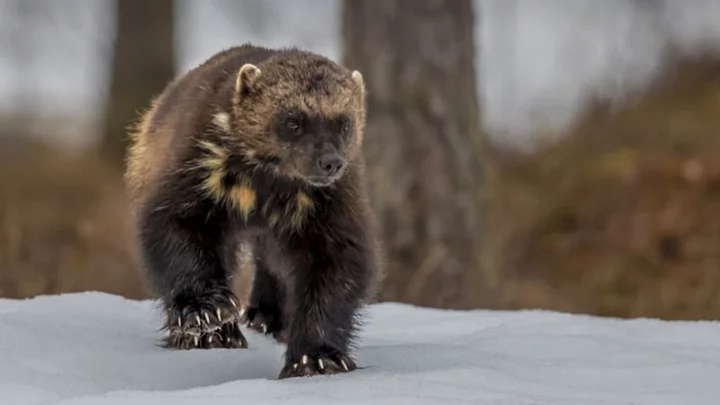When you hear wolverine, your first thought may be the super-buff, clawed comic book character. That depiction isn’t too different from the actual animal, a member of the weasel family that also has some pretty sharp claws. Once hunted nearly to extinction for their fur, wolverines in the lower 48 states now face threats from habitat fragmentation and climate change. In November 2023, they were added to the U.S. Endangered Species List (and their populations are decreasing worldwide).
These animals are elusive, and much about them remains mysterious—but here are a few things we do know.
1. Wolverines are made for cold weather.
Wolverines can be found in boreal forests and tundra in North America, Europe, and Asia, where temperatures are cool even in the summer, so it’s no surprise that these animals have evolved to survive frigid weather. They have big paws that that spread to twice their size when they hit the ground, distributing their weight to help them travel through snow (they can run up to 30 mph), and thick, oily fur that resists frost—a fact that made them a target for fur traders.
2. Its scientific name means “the glutton”—and it’s an apt description.
At four feet tall and weighing up to 22 pounds (females) and 40 pounds (males), these fierce creatures are the largest members of the weasel family. They’re small compared to some of the animals they compete with for food, but a wolverine has no problem standing up to wolves or a bear when a meal is on the line.
Wolverines—or Gulo gulo, scientifically speaking— are opportunistic eaters that hunt live prey including small animals like hares and rodents as well as larger animals, like caribou, that are weak or ill. They’ll also scavenge from any carcass they can get their claws on. (They eat vegetables and berries, too.) Frozen meat isn’t a deterrent: An upper molar that sits sideways at 90 degrees lets them rip into ice-covered carcasses. Their teeth are so sharp and strong that they can even eat bones. Once wolverines have food, they often bury it to save it for later; mere hours after a meal, they’ll go on the hunt again.
3. They burrow.
Wolverines use their non-retractable claws not just to bury food, but also to build dens; females dig as deep as 15 feet into snow to create burrows for their young. But the claws aren’t just good for digging: They also allow the animals to climb trees (though, as the video above shows, they’re not exactly adept at it).
4. Wolverines are stinky.
The stench comes from special anal glands that allow the animals to emit an offensive odor that protects their food and marks their territory (they’ll also use it when threatened, raising their tails like skunks). The fragrant odor has traces of methylbutanoic acid (think smelly cheese), methyldecanoic acid, and phenylacetic acid, and has a composition similar to those of pine and beech martens.
5. They’re not the strongest mammal, according to bite force.
Folktales suggest that wolverines are the strongest animals in nature, but science has proved this to be largely untrue. These animals can be aggressive, but they only have a moderately strong bite: According to findings published in a 2007 study in the journal Ecology, the animal’s bite force at the canines is 224 Newtons. Compare that to the highest number, 1646.7 Newtons, which belongs to the polar bear. Grizzlies, tigers, and lions aren’t far behind.
The researchers also calculated bite force quotient (BFQ) to compare the bite force of animals with differing body sizes. According to the scientists, “Species with BFQs around 100 may be regarded as having near ‘average’ bite force for their body size.” Wolverines come in at around 105—in other words, pretty average. The palm civet (161.1) and the sun bear (160.5) both rank higher, as do several other weasels. The animal in the paper with the highest BFQ is Mustela nivalis, or least weasel, at 164. Outdoing them all is the Tasmanian devil, which has a BFQ of 181.
6. They have an amazing sense of smell.
Wolverines can smell prey even when it’s buried under 20 feet of snow, and have been known to find and kill hibernating animals.
7. Wolverines can travel vast distances.
When looking for food, wolverines can cover as many as 15 miles in a single day. In the United States, these mostly solitary creatures each wander a territory of 47 square miles, and in Scandinavia, they roam individual territories that stretch over more than 270 miles. But that’s nothing compared to the distance one wolverine covered in 2009: Scientists figured out that the animal, which was spotted in Colorado, had trekked over 500 miles from its home in Wyoming.
8. They’re polyamorous.
In the wild, wolverines have a life span of seven to 12 years. When they reach sexual maturity, around age 2, one male will mate with several females he allows to live in his territory in the spring and summer months. Implantation of the fertilized eggs is delayed until the fall/winter, after which gestation lasts from four to seven weeks. Females typically give birth to an average of three kits, which are under five inches long, weigh just a few ounces, and are covered in snow-white fur. By the time the kits are 6 weeks old, they’re exhibiting darker fur; each animal will develop unique coloration patterns on its face, neck, and chest. Kits stick with their moms for at least a year, and sometimes longer, and dad often returns to help out.
9. Wolverines are really smart.
These animals use low-traffic human roads when traveling through their territory and can sneak bait out of traps set by scientists who want to collar them for study.
10. Other animals are sometimes mistaken for wolverines.
Fishers, badgers, marmots, bear cubs, and porcupines all look like wolverines from a distance.
11. Scientists continue to study the elusive, mysterious animals.
Groups like the Citizen Wildlife Monitoring Project have spotted wolverines with remote cameras mounted in wilderness areas of Washington State, and the University of Alberta monitors wolverines by partnering with trappers and attaching GPS collars to the animals in western Canada.
A version of this story was published in 2016; it has been updated for 2023.
This article was originally published on www.mentalfloss.com as 11 Fierce Facts About Wolverines.









